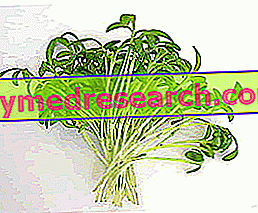The article that follows is aimed at describing watercress, a plant with marked aromatic characteristics.
In Italy, with the term crescione (in addition to the famous Romagna gastronomic preparation, which has nothing to do with what will follow) we indicate TWO types of herbaceous:
- the garden cress (in English garden cress );
- the water cress ( rorippa or schino ).
Both belong to the Brassicaceae family, but differ substantially in genus, species, habitat, cultivation, properties and uses.
Garden cress
Generalities and description of the garden cress
Garden cress is a plant belonging to the Brassicaceae family, Genus Lepidium, Species sativum ; its binomial nomenclature corresponds to Lepidium sativum .

The garden cress can reach 60cm in height (but it is generally taken within 20cm) and has the ability to branch out in the upper part of the plant. The stem and leaves are bright green, while in the vicinity of the roots it is lighter; the flowers are small, grouped and pinkish-white.
Garden cress cultivation and trade
Garden cress is widely cultivated (both commercially and privately) in England, France, Holland and Scandinavia; in Italy it is a product of secondary importance. It lends itself to hydroponic crops and thrives in slightly alkaline water. Often, the supply of the market is not sufficient to cover the needs of the populations that use it widely; this is due to the need to consume it mainly FRESH.
Garden cress is quite easy and quick to grow independently, both with seeds and with transplanting small plants; in general, 7-14 days of growth after sowing are sufficient to reach 5-13cm in height.
Garden cress has an extremely rapid development, therefore it is used as a Specie-Test for monitoring the healthiness of the soil.
Garden cress in the kitchen
Garden cress is excellent in soups and sandwiches; in the form of sprouts (fresh or dried), it also represents a spicy aromatic component for salads (in Indian: halloon ). The typical Anglo-Saxon sandwich with garden cress is composed of boiled eggs, mayonnaise and salt.
Phytotherapeutic characteristics and other uses of garden cress
Garden cress is one of the components of Ayurveda medicine; according to Indian tradition, the seeds of this herbaceous plant can be used for different healing purposes. These include: amaricante, thermogenic, purifying, rubefacient, galactogogic, tonic, aphrodisiac, ophthalmic, antiscorbutic, antihistamine and diuretic. On the basis of the same current of thought, the seeds of garden cress are therefore useful in the treatment of: asthma, cough with expectoration, compresses for sprains, leprosy, skin diseases, dysentery, diarrhea, splenomegaly, dyspepsia, lumbago, leucorrhea, scurvy and seminal weakness.
The garden cress has also aroused the curiosity of Western medicine; it seems that his seeds have been shown to reduce the symptoms of asthma, improve lung function in asthmatic subjects and reduce glycaemia (see bibliography).
Seed mucilage is used as a substitute for gum arabic and tragacanth gum.
Bibliography:
- A study on clinical efficacy of Lepidium sativum seeds in the treatment of bronchial asthma - NP, Archana; Anita, AM (2006) - Ir an J Pharmacol Ther 5 : 55-59
- Study of hypoglycaemic activity of Lepidium sativum L. aqueous extract in normal and diabetic rats - M, Eddouks; Maghrani M, Zeggwagh NA, Michel JB (2005) - J Ethnopharmacol 97 : 391-395.
Watercress
Generalities and description of water cress
Watercress is an aromatic herb belonging to the Brassicaceae family, Genus Nasturtium, officinal species; the binomial nomenclature of water cress is Nasturtium officinale .

Watercress is a plant that grows along calm and unpolluted watercourses in the plains, mountains and all the temperate zones of the planet. The plant needs to keep the roots totally soaked or always very humid; the positioning of the ground must be shady. The stems are prostrate or erect, hollow and long up to 50 / 100cm. The watercress has green, shiny, fleshy and alternate leaves. The flowers are small, with white petals, and are gathered in summit clusters. The fruits are cylindrical siliques containing seeds. The roots are collated and adventitious near the ground.
The water cress can be confused with the bitter Cardamine, recognizable by its opaque leaves and the absence of the organoleptic and gustatory characteristics typical of watercress.
History of water cress
Watercress is an aromatic officinale plant, both wild and cultivable. The gastronomic use of this vegetable dates back to ancient times (Persians, Greeks, Romans), when it was believed that its usual consumption could enhance intellectual abilities. Watercress is also involved in numerous myths and legends, which is why it was widely sold until a few years ago.
Phytotherapeutic properties of water cress
Excluding myths, legends and beliefs, water cress has some real phytotherapic characteristics and others that are less tangible. Among all we remember: remineralising, diuretic and purifying, antianemic, expectorant, hepatic and hypoglycemic decongestant; it is also recommended for lung diseases.
Watercress in the kitchen
The water cress should be consumed mainly "cooked" and thoroughly washed, especially in case of collection at waterways of doubtful healthiness. The plant is the object of gastronomic elaboration to obtain: mixed cooked herbs (also repassed), flavored egg omelettes, minestrones, acquacotta (Florentine) etc. Obviously, as with most aromatic plants, the heat treatment significantly affects not only the aroma and taste, but also the chemical-nutritional properties; therefore, with a good hygienic standard, it is possible to consume the watercress raw in the mixed salad (with pimpinella, rocket, etc.) or alone. By chopping the leaves we obtain sauces with a particularly intense taste.
In Italy, it is instead a typical ingredient of Romagna "watercress".
Nutritional characteristics
The nutritional intake of the two types of watercress is quite interesting. They do not supply large amounts of energy (however greater in the garden cress) and the portion of water is absolutely predominant; the fiber is also quite scarce.
On the other hand, as far as mineral salts and vitamins are concerned, it can be said that the garden cress contains high concentrations of potassium, iron, riboflavin, vit. A (carotenoids - retinol equivalents) and vit. C (ascorbic acid). The watercress, on the other hand, besides being rich in the nutrients mentioned (although not at the levels of the previous one), has a higher calcium content.
Nutritional values
 | |||||
| Garden cress | Watercress water | ||||
| water | 89.5g | 95.1g | |||
| Protein | 2.6g | 2.3g | |||
| Prevailing amino acids | - | - | |||
| Limiting amino acid | - | - | |||
| Lipids TOT | 0.5g | 0.1g | |||
| Saturated fatty acids | 0.02mg | 0.03mg | |||
| Monounsaturated fatty acids | 0.24mg | 0.01mg | |||
| Polyunsaturated fatty acids | 0.23mg | 0.04mg | |||
| Cholesterol | 0.0mg | 0.0mg | |||
| TOT Carbohydrates | 5.5g | 1.3g | |||
| Starch | 1.1g | 1.1g | |||
| Soluble sugars | 4.4g | 0.2g | |||
| Dietary fiber | 1.1g | 0.5g | |||
| Soluble fiber | -g | -g | |||
| Insoluble fiber | -g | -g | |||
| Power | 35.5kcal | 15.0kcal | |||
| Sodium | 80.0mg | 41.0mg | |||
| Potassium | 606.0mg | 330.0mg | |||
| Iron | 1.3mg | 0.2mg | |||
| Football | 76.0mg | 120.0mg | |||
| Phosphorus | 76.0mg | 60.0mg | |||
| Thiamine | 0.08mg | 0.09mg | |||
| Riboflavin | 0.26mg | 0.12mg | |||
| Niacin | 1.00mg | 0.20mg | |||
| Vitamin A | 346.0RAE | 160.0RAE | |||
| C vitamin | 69.0mg | 43.0mg | |||
| Vitamin E | 0.7mg | 1.0mg | |||



